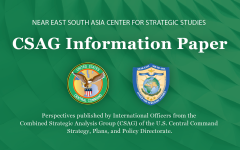CSAG Strategy Paper: Panacea for Gaza
April 12, 2024 2024-04-12 13:08CSAG Strategy Paper: Panacea for Gaza
CSAG Strategy Paper: Panacea for Gaza
CSAG STRATEGY PAPER
COL Mohammed Sayed, Egyptian Army (CSAG/CCJ5), LTC Rene Berendsen, Royal Netherlands Army (CSAG/CCJ5), and CDR Hubert Mróz, Polish Navy (CSAG/CCJ5)
1 April 2024
Overview:
The quest for stability in Gaza has long been a focal point of international attention, particularly in the context of the Israeli-Hamas conflict and the broader Palestinian issue. However, the traditional approach to addressing this complex challenge may be overly narrow in scope. It is increasingly evident that a comprehensive regional solution, rather than a singular focus on Gaza, may hold the key to sustainable peace and stability in the region.
The concept of a “Two-state Solution” has often been touted as the most viable path towards resolving the Israeli-Palestinian conflict. However, the ambiguity surrounding this term raises critical questions about its true meaning and feasibility. Politicians frequently invoke this phrase as a catch-all solution without delving into the nuanced details required for its successful implementation. This lack of clarity not only undermines public understanding but also risks reducing the “Two-state Solution” to a mere “buzzword” devoid of substantive content.
Any approach towards stabilizing Gaza is inherently complex and multifaceted, necessitating a series of incremental steps that demand time, patience, and unwavering commitment. While various stakeholders advocate for different strategies, Israel’s specific roadmap for stabilizing Gaza remains largely undisclosed, with the focus primarily centered on addressing the Hamas factor.
Moreover, significant obstacles loom on the path to stabilization, with the imperative need for a ceasefire emerging as a fundamental prerequisite for any potential progress. Despite this essential requirement, Israel’s seeming reluctance to engage in ceasefire discussions, and certainly its uncompromising public rhetoric, poses a formidable challenge that must be navigated to pave the way for constructive dialogue and meaningful solutions.
In light of these considerations, this paper proposes a comprehensive plan supporting the idea of a “Two-state Solution” as a means to address these multifaceted challenges, aiming for a strategic environment conducive to the stabilization of Gaza and the broader region.
Key Points:
- The complexity of the Israel-Palestine conflict is rooted in the late 19th century and is enduringly exacerbated by polarization and radicalization on both sides.
- The adoption of a Gaza-centric approach is deemed inadequate, as a comprehensive regional comprehension of the matter, coupled with a regional strategy, is posited as the sole viable means to address the issue effectively; any approach towards stabilizing Gaza is inherently complex and multifaceted, necessitating a series of incremental steps that demand time, patience, and commitment.
- In exploring potential approaches to Gaza stabilization, three distinct strategies emerge: “Painkiller” (by Israel), “Placebo” (by the US), and “Panacea” (Israel-Palestine 3-Phase Plan (IP3PP) by CSAG).
- The CSAG IP3PP is a comprehensive 3-Phase Plan that consists of three Lines of Effort (Security, Governance, Development), Decisive Conditions and Decision Points to achieve three objectives (Security, Sovereignty, Integration) that will contribute to a stable and prosperous region.
View other USCENTCOM Combined Strategic Analysis Group (CSAG) papers here.
The opinions and conclusions expressed herein are those of a number of international officers within the Combined Strategic Analysis Group (CSAG) and do not necessarily reflect the views of United States Central Command, not of the nations represented within the CSAG or any other governmental agency.



